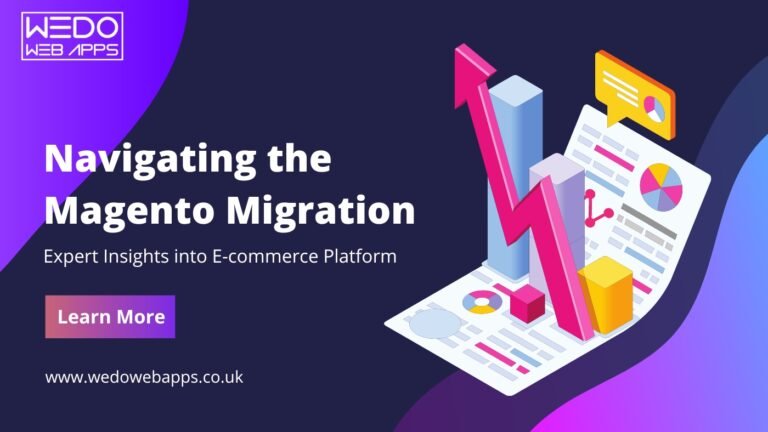19 Jul, 2023 | ecommerce development company
Navigating the Magento Migration Services Landscape: Insights into E-commerce Platform

Section 1: Magento Migration Demystified
Defining Migration
Before embarking on our journey, it's vital to get a grasp on the concept of migration within the context of e-commerce. In simple terms, migration refers to the process of moving data, functionality, and design from one environment to another. In this case, our focus lies primarily on Magento, a popular e-commerce platform, migration.Section 2: A Glimpse into the Magento Landscape
Magento has established itself as a robust and reliable e-commerce platform. Yet, like all technology, it has seen advancements and transformations. This leads us to our next keyword - Magento migration from 1 to 2.Transitioning from Magento 1 to Magento 2
Magento 2 emerged with a promise of better functionality, improved performance, and enhanced user experience over its predecessor, Magento 1. However, this upgrade means that businesses must undergo the meticulous process of migrating their stores from Magento 1 to Magento 2. This involves migrating data, themes, extensions, and customisations, ensuring minimal downtime, and testing rigorously to ensure a smooth customer experience post-migration.Section 3: The Role of a Magento Migration Agency
Here is where a Magento migration agency enters the scene. The task of migration, as mentioned above, can be complex and demanding, requiring specialist knowledge and experience.Embracing Expert Magento Migration Services
A proficient Magento migration agency is adept at managing the various complexities associated with the process. These agencies have well-laid plans, robust tools, and dedicated teams, making the transition as smooth as possible while mitigating risks and ensuring business continuity.Section 4: Decoding the Magento Migration Process
Navigating the Magento migration process can feel like a labyrinth. However, with a clear roadmap and guidance from a Magento migration agency, it can be simplified.Crafting a Magento Migration Plan
A successful migration requires a meticulously crafted plan, including backup measures, rigorous testing, scheduled downtimes, and prompt post-migration support. This plan serves as a blueprint for the entire migration process, aligning all stakeholders, and ensuring minimal disruption to ongoing business operations.Section 5: Weighing Your Options: Migration from Magento to Shopify
As e-commerce platforms continue to evolve, businesses are presented with an array of choices. For instance, some businesses might contemplate migration from Magento to Shopify, another leading e-commerce platform.Magento vs Shopify: A Migration Perspective
In comparison to Magento, Shopify is a platform known for its user-friendly interface and lesser technical complexities. However, Magento is unrivalled in terms of its customisation capabilities and scalability. Choosing between the two will depend on your business needs, size, and long-term goals.Section 6: The Benefits of Migrating to Magento 2
Unpacking the Advantages
Migrating from Magento 1 to Magento 2 opens up a plethora of benefits for online businesses. Magento 2 provides a wealth of improved features and functionalities. Notably, enhanced speed, optimised web pages for faster delivery, streamlined checkout processes, and superior backend operations – all contributing to a more seamless customer experience and increased sales.Section 7: The Role of a Magento Migration Agency in Your Upgrade
Ensuring a Smooth Transition
Hiring a proficient Magento development agency is crucial to mitigating the potential issues that can arise during the migration process. They offer comprehensive Magento migration services, including initial consultation, planning, data migration, design and functionality replication, testing, and post-migration support. The expertise of such an agency significantly reduces the risk of data loss, site downtime, and other migration-related issues.Section 8: The Steps Involved in a Magento Migration Process
Detailed Process Breakdown
The Magento migration process is multifaceted, involving several critical steps. From creating a duplicate Magento 1 store, migrating the data and extensions, setting up and customising the theme, to finally testing the Magento 2 store extensively before going live – a detailed understanding of these steps is crucial for successful migration.Section 9: Planning Your Magento Migration
Key Components of a Magento Migration Plan
A well-structured Magento migration plan can make the process smoother and more efficient. Key components of such a plan include creating backups of your Magento 1 store, carefully selecting and migrating extensions, planning for SEO continuity, and organising post-migration reviews and adjustments.Section 10: Considering a Shift from Magento to Shopify?
Assessing Your Business Needs
Some businesses might find that a migration from Magento to Shopify better suits their needs. Shopify is known for its user-friendly approach, requiring less technical expertise compared to Magento. However, Magento offers greater customisation and scalability, making it a superior choice for larger businesses or those planning significant growth.Section 11: Final Words
Migrating your e-commerce store is a significant business decision. Whether you're upgrading from Magento 1 to Magento 2 or considering a platform switch to Shopify, understanding the migration process and seeking the expertise of a Magento migration agency can ease the transition. Remember, your e-commerce platform should align with your business goals, customer needs, and future growth strategies. We hope this comprehensive guide provides you with the insight you need to embark on your Magento migration journey. Whatever your decision may be, it’s a path towards progress, better user experience, and long-term business growth. Migrating to Magento can significantly enhance your eCommerce capabilities. Partner with a trusted Magento Adobe Commerce agency to ensure a seamless transition. Additionally, consider the benefits of price comparison website development to boost your competitive edge.Frequently Asked Questions
In the e-commerce realm, migration refers to the process of transferring data, design, and functionalities from one environment to another. In the context of Magento migration, this involves moving an online store from an older version of Magento (e.g., Magento 1) to a newer version (Magento 2) or to another e-commerce platform like Shopify.
Magento 2 offers a range of enhancements over its predecessor, Magento 1. These improvements include increased speed, optimised web pages, streamlined checkout processes, and superior backend operations. Furthermore, official support and updates for Magento 1 have ceased, making the migration to Magento 2 a necessary step for continued performance and security.
A Magento migration agency provides comprehensive services to facilitate a smooth migration from Magento 1 to Magento 2. The agency helps plan the migration, ensures data safety, aids in theme and functionality replication, performs rigorous testing, and provides post-migration support. Hiring an agency reduces the risk of data loss, site downtime, and other migration-related issues.
The Magento migration process involves several steps: setting up a Magento 2 store, migrating data from Magento 1 to Magento 2, installing and configuring extensions, setting up the theme and customising it, and then rigorously testing the new store before it goes live.
A Magento migration plan should include several key components: creating backups of your Magento 1 store, carefully selecting and migrating necessary extensions, planning for SEO continuity to ensure your store's visibility isn't affected, and scheduling post-migration reviews and adjustments.
The decision to migrate from Magento to Shopify depends on your business needs. Shopify is user-friendly and requires less technical expertise, making it suitable for small businesses or those with straightforward requirements. However, Magento offers greater customisation possibilities and scalability, making it an excellent choice for larger businesses or those anticipating significant growth.
Migrating to Magento 2 provides several benefits. These include enhanced page load speeds, optimised checkout processes, improved backend operations, better mobile shopping experience, and advanced reporting features. These improvements lead to better customer experience, increased conversions, and ultimately, higher sales.
While it is technically possible to handle the migration process yourself, it is generally recommended to engage a Magento migration agency. The process can be quite complex and technical, and any errors or data loss during migration could seriously impact your business. A migration agency has the necessary expertise and experience to ensure a smooth and successful migration.

